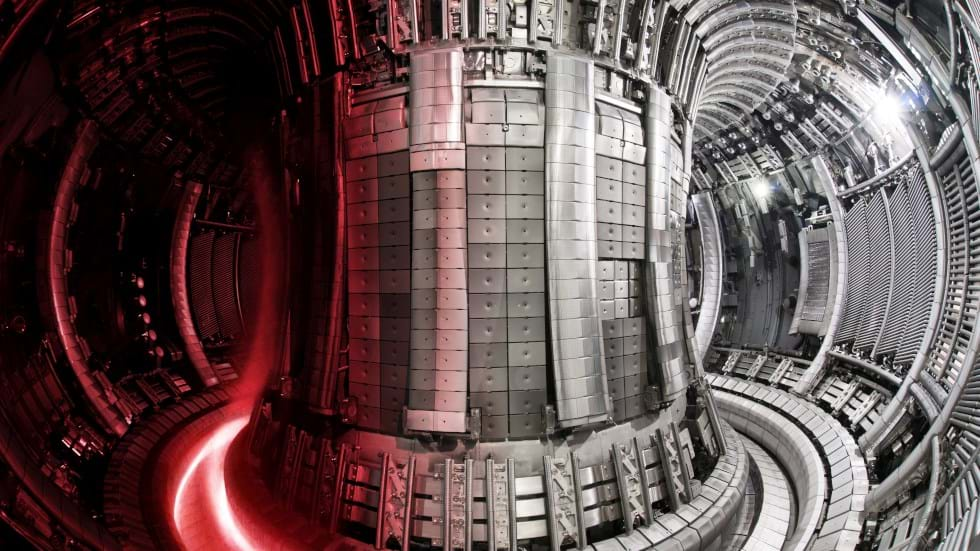Final deuterium-tritium tests begin at the UK-based Joint European Torus fusion facility

YESTERDAY scientists and engineers at the UK Atomic Energy Authority’s Culham site, in Oxfordshire, started running the third and final experiments using deuterium-tritium fuel at the Joint European Torus (JET) research project. The experiments will inform the design and operation of next generation fusion machines, playing a vital role in shaping future projects.
Operated by the UK’s Atomic Energy Authority (UKAEA), JET is currently the largest and most powerful operational tokamak, and the only experiment able to operate with the deuterium-tritium fuel mix that will be used for commercial fusion. It is collectively used by all the European fusion laboratories within the EUROfusion consortium, a collaboration for fusion energy development including the EU, Switzerland, Norway, and the UK.
The deuterium-tritium experiments, which are being run under a campaign known as DTE3, will continue for seven weeks and focus on three areas: plasma science, materials science, and neutronics. Also known as neutron transport, neutronics is the study of how neutrons move and interact with materials.
The aims of the 36 experiments planned by researchers include reducing heat load on the divertor exhaust system by injecting impurities into the plasma without compromising performance. In machines like JET, which use the tokamak reactor concept, an exhaust system known as a divertor removes both extreme heat and impurities from the hot plasma fuel. Tokamaks use powerful external magnetic fields to confine and control the hot plasma of fusion fuels in a ring-shaped container called a “torus”.
Researchers will also use a diagnostic method called “laser induced desorption” to measure the amount of tritium in the surface of the wall materials; improve real-time control of the plasma heat load; and work to understand the impact of bombarding neutrons on in-vessel materials, electronic components, and data acquisition systems.
Joelle Mailloux, JET science programme leader at UKAEA, said: “There has been real excitement ahead of the start of the DTE3 campaign and about the opportunity to study areas of science important to the design and operation of the next generation of fusion machines. The DTE3 programme is based on decades of research and, with the DTE2 results, will play a vital part in shaping the future of fusion.”
Emmanuel Joffrin, leader of the tokamak exploitation EUROfusion task force said: “This new DT campaign represents the culmination of several years of cooperative research within the EUROfusion consortium programme. Europe’s integrated approach to fusion research and innovation is bringing together researchers and knowledge from a number of European tokamaks in a common goal and comprehensively address the challenges ahead to realise fusion energy, as outlined in our strategic roadmap. With the DTE3 experiments we will provide much needed input to the future operation of ITER and fusion powerplants, testing all the elements in an integrative manner. We are very excited and look forward to the results of this last round of DT experiments.”
The UKAEA said it will publish regular updates on DTE3 across its digital channels.
JET’s contribution and next steps
These coming experiments follow a set run in late 2021, part of the DTE2 campaign, during which JET demonstrated sustained fusion over five seconds at high-power and set a world record. Fusion researchers said the achievement was the clearest indication in half a century that fusion technology can produce abundant low-carbon energy. JET’s first deuterium-tritium experiments took place in 1997.
JET’s research findings will be critical to developing ITER, a larger more advanced version of JET.
Set to be the world’s largest tokamak, the ITER is being built in southern France supported by the project’s seven members: China, the EU, India, Japan, Korea, Russia, and the US.
Its findings also have important implications for the UK’s Spherical Tokamak for Energy Production (STEP) prototype powerplant, which will be built in West Burton, Nottinghamshire; the European DEMO prototype fusion plant, a demonstration power plant that will succeed ITER; and other national laboratory and private projects around the world.
Having started operating in 1983, JET is set to undergo repurposing and decommissioning from early 2024 until 2040. UKAEA notes that in early 2024 a celebration is planned to acknowledge the project’s contribution to fusion science and engineering. “JET has played a critical role in accelerating the development of fusion energy, which promises to be safe, low carbon, and sustainable part of the world’s future energy supply,” the UKAEA said.
Recent Editions
Catch up on the latest news, views and jobs from The Chemical Engineer. Below are the four latest issues. View a wider selection of the archive from within the Magazine section of this site.




